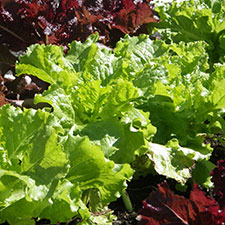Yesterday as we started the 5th or 6th day of cloudy, wet, high-humidity weather, my inbox had an article from producegrower.com on preliminary results of trials at The Ohio State University by Dr. Chieri Kubota, Director of the Ohio Controlled Environment Agriculture Center (OHCEAC) and Professor in the Department of Horticulture and Crop Science, and one of her graduate students, PhD candidate John Ertle. They rated the sensitivity of 20 lettuce cultivars to prime conditions to induce lettuce tipburn, exactly the conditions we’ve had this past week.
As they reported, “Tipburn is caused by calcium deficiency often seen in lettuce (Lactuca sativa) when plants are grown quickly under optimum environmental conditions. The deficiency is also known as “localized” around young leaves at the shoot tip. Therefore, tipburn occurs even with sufficient calcium fertilization of the whole plant.”
While their work was conducted for Controlled Environment Ag (CEA) production, conditions in field production can and often does replicate the controlled environment they created to induce tipburn (same issue with Blossom End Rot of tomatoes, peppers, and eggplants). Namely, “conditions that promote overall plant growth (high light, high CO2) yet suppress plant transpiration rate (low air circulation, high humidity) are known to increase the risk of tipburn. In addition, low humidity (high VPD) during nighttime increases tipburn risk in some cases.”
[Citing some of her own work, Kubota explained,] “This is because low humidity at night promotes non- stomatal transpiration (loss of water from leaf surface), reducing xylem pressure and calcium supply to the shoot tip at night.”
The Ohio State team compared various cultivars supplied by different seed companies under controlled growth conditions to induce tipburn and reported significant differences in the severity and time to beginning of symptoms, ranging from 0 to 58%. Yields were not correlated with tipburn incidence.
Researchers in California reported in Overview of Tipburn of Lettuce that their field studies also found significant differences in tipburn severity among cultivars. Richard Smith et al. concluded, “The greater issue for the development of tipburn in lettuce is the variety,” and that “persistent foggy conditions that reduce transpirational flow of calcium to all parts of the leaves in the last 6-10 days prior to harvest will trigger this disorder in sensitive varieties.”
Unfortunately, studies to find effective controls of tipburn indicate little can be done, including having adequate Ca in soils and foliar applications of Ca during the growing season. The Ca just doesn’t get to the rapidly growing tissue in time to reduce the damage. The general conclusion is to conduct your own field trials to determine best varieties for your farm.

